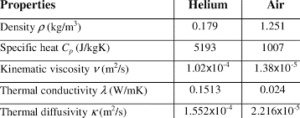Helium, the upper right element on the periodic table. The first of the “rare gases” or “noble gases.” Helium has two protons, two electrons and two neutrons. Its atomic weight is 4.0026. In case you are wondering, the extra .0026 mass is the rest mass of energy from nuclear spin and nuclear bonds. Pub chem gives us the basic scoop on Helium and compares it to “air” which is a mixture of elements. The most important property for Helium at STP (Standard Temperature and Pressure) is its density which is about 1/8 of air causing a Helium balloon to float in the air.

But Helium is the only element on this planet that is capable of leaving the earth’s gravity. In the upper atmosphere, Helium atoms achieve a distribution of velocities (a property of temperature) so that some of the Helium is moving faster than the escape velocity of the earth. Those atoms that are moving away from the earth, never return. Bye bye, Helium. We recover Helium from natural gas wells. There is only so much of it in the planet, and then it is gone.
Helium is strategically important. We cannot cool Magnetic Resonance Imaging magnets without Helium. Our most powerful lasers require Helium. It is used in welding, breathing mixtures for divers, and to provide “controlled non-oxidative” atmospheres for manufacturing and pharmaceuticals. Fearing the disappearance of such an important NON-renewable natural resource, the United States government established the “Strategic Helium Reserve” in 1925. This far-sighted move was privatized in 1995 and the US government sold its Helium on the open market below production costs.
That situation lasted a few years and has been replaced by an auction system. Helium can only be produced from natural gas wells that are capped underground with an anhydrate salt – a rare situation globally. I write this because 2021 is the year some have projected that the auctioned Helium purchased by private companies will be completely sold out. Global production and recovery from existing operations (like MRI scanners) is not enough to meet the demand.
And yet, because of some misguided belief in free markets, we take an essential, vital non-renewable resource like Helium and fill balloons with it to entertain children. As demand outstrips production, the price will skyrocket. MRI costs that are already sky high will go to the moon. I am beginning to think that the US government in 1925 was a lot wiser than the free-marketeers of 1995.
